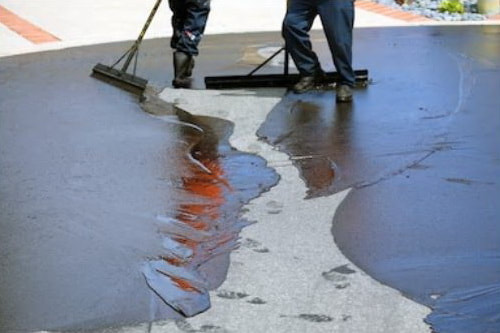Revitalize Angle Parking Lots: Asphalt Sealing Approaches Exposed
Wiki Article
Cold Mix Asphalt Vs. Hot Mix Asphalt: Which Is Right for You?

Composition Differences
Cold mix asphalt is generated by emulsifying the asphalt binder with water and an emulsifying representative before blending it with accumulation. The hot mix asphalt manufacturing procedure involves heating up the accumulation and asphalt binder separately before integrating them at the asphalt plant.
Moreover, chilly mix asphalt has a tendency to be less dense and more versatile than hot mix asphalt. This flexibility makes it much better suited for locations with higher degrees of motion, such as driveways or roads with rush hour. In comparison, warm mix asphalt is recognized for its high longevity and resistance to rutting and fracturing, making it a preferred choice for highways and high-traffic roads where longevity is critical.
Installation Process Variances
The procedure of installing cool mix and warm mix asphalt displays remarkable variations in their treatments and demands. Cold mix asphalt, being a more flexible material, can be applied directly from the bag or container onto the pothole or damaged location. It requires marginal preparation job, such as cleaning the location and condensing the cool blend with hand devices. This makes it a practical choice for quick and short-term solutions. On the other hand, hot mix asphalt demands an extra sophisticated installation procedure. It involves warming the combination to heats before laying it down on an appropriately prepared base. The preparation consists of condensing the base, applying a tack coat, and making use of heavy equipment like pavers and compactors for a durable and smooth coating. As a result of the heating requirements, warm mix asphalt setups are generally performed by specialists with specific devices, making certain a much more irreversible and structurally sound outcome.Longevity and Durability Elements
When thinking about asphalt alternatives, sturdiness and long life are crucial aspects to assess for enduring sidewalk performance,. Warm mix asphalt (HMA) is recognized for its remarkable longevity and longevity. The heats throughout the laying and mixing procedure permit better compaction, leading to a denser and stronger pavement framework. This results in HMA being more resistant to heavy traffic tons, harsh weather problems, and the results old contrasted to chilly mix asphalt (CMA)
In terms of long life, HMA commonly surpasses CMA as a result of its remarkable toughness and resistance residential properties. HMA pavements have a longer solution life, calling for less constant repairs and upkeep, which can equate to set you back financial savings over time. Furthermore, HMA sidewalks are extra conveniently personalized to meet certain job needs, additionally boosting their durability.
Cost Factors To Consider
Considering the financial implications is a vital element when examining the selection in between warm mix asphalt (HMA) and cold mix asphalt (CMA) for pavement jobs. While the initial price of hot mix asphalt is commonly greater than that of cool mix asphalt, HMA commonly offers a more economical service in the lengthy run due to its premium durability and durability.In addition to material costs, it's crucial to consider the costs linked with setup and upkeep when contrasting HMA and CMA. Ultimately, the choice between HMA and CMA ought to take right into account not simply the initial cost yet also the long-lasting monetary implications to determine the most cost-efficient alternative for the specific sidewalk task.
Environmental Effect Contrast
Contrast of the environmental effects in between warm mix asphalt (HMA) and cold mix asphalt (CMA) discloses distinctive differences in sustainability techniques. HMA manufacturing calls for heats, causing boosted energy intake and greenhouse gas discharges. The procedure also launches volatile asphalt patch repair organic compounds (VOCs) and hazardous air toxins (HAPs) right into the environment. In contrast, CMA is generated and applied at lower temperature levels, lowering energy usage and exhausts dramatically. The lower manufacturing temperatures of CMA result in lowered gas consumption and reduced degrees of carbon dioxide exhausts, making it a much more ecologically friendly choice.Additionally, the usage of CMA typically involves recycling existing asphalt pavement, promoting resource conservation and decreasing the quantity of waste sent out to garbage dumps. By choosing for CMA over HMA, roadway building tasks can add favorably to ecological conservation initiatives.
Conclusion
To conclude, the option in between cool mix asphalt (CMA) and hot mix asphalt (HMA) relies on various elements such as structure, setup process, toughness, durability, price, and environmental effect. asphalt repair. While CMA supplies a quick and affordable solution for minor repair services, HMA makes certain exceptional resilience and long life for rush hour areas. Think about these aspects carefully to figure out which sort of asphalt is the right choice for your paving needs

Considering the financial ramifications is a vital facet when examining the choice in between hot mix asphalt (HMA) and cool mix asphalt (CMA) for sidewalk jobs. While the first price of hot mix asphalt is generally greater than that of chilly mix asphalt, HMA frequently offers a much more cost-efficient option in the long run due to its exceptional sturdiness and long life. asphalt patch repair.Contrast of the ecological effects between warm mix asphalt (HMA) and chilly mix asphalt (CMA) discloses unique differences in sustainability techniques.In final thought, the selection in between cool mix asphalt (CMA) and hot mix asphalt (HMA) depends on various aspects such as make-up, installation procedure, toughness, longevity, price, and environmental effect
Report this wiki page